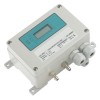Voltage signal transducers with an integral digital indicator for displaying and sending pressure readings.
Pressure transducers with built-in gauge readouts include the same basic electrical functionality of a voltage output pressure transducer and can also include additional functionality, such as configurable engineering units and alarm contact switches. No batteries are required since the digital gauge takes power from the voltage supplied to the pressure transducer.
Products
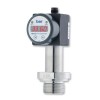 DS200P Sanitary Low Range Pressure Gauge, Switch and Sensor - All in one electronic switch, gauge and sensor designed specifically for use in the food, drink and biomedical industry for measuring process pressures.
DS200P Sanitary Low Range Pressure Gauge, Switch and Sensor - All in one electronic switch, gauge and sensor designed specifically for use in the food, drink and biomedical industry for measuring process pressures.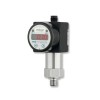 DS210 Combined Low Pressure Switch, Indicator and Sensor - Low range three in one pressure switch, pressure indicator and pressure sensor for use on pneumatics and HVAC applications.
DS210 Combined Low Pressure Switch, Indicator and Sensor - Low range three in one pressure switch, pressure indicator and pressure sensor for use on pneumatics and HVAC applications.
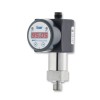 DS200 Combined Pressure Switch, Gauge and Sensor
DS200 Combined Pressure Switch, Gauge and Sensor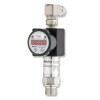 DS201P High Range Flush Pressure Gauge, Switch and Sensor
DS201P High Range Flush Pressure Gauge, Switch and Sensor
Applications
 3000 psig range 0-10Vdc output digital display pressure transducer for hydraulic control use - A digital display pressure transducer for hydraulic control use to measure pressure of mineral hydraulic oil over a range of 0 to 3,000 psi g from the 1/4 NPT male process connection, and sending the corresponding 0-10Vdc signal through the DIN plug electrical connection.
3000 psig range 0-10Vdc output digital display pressure transducer for hydraulic control use - A digital display pressure transducer for hydraulic control use to measure pressure of mineral hydraulic oil over a range of 0 to 3,000 psi g from the 1/4 NPT male process connection, and sending the corresponding 0-10Vdc signal through the DIN plug electrical connection. 5psig 0-10V out freshwater pressure transducer and built-in display for water purifier use - A combined digital display and low range gauge pressure transducer for water purifier use to measure pressure of freshwater over a range of 0 to 5 psi g from the 1/2 NPT male process connection, and sending the corresponding 0-10Vdc signal through the DIN plug electrical connection.
5psig 0-10V out freshwater pressure transducer and built-in display for water purifier use - A combined digital display and low range gauge pressure transducer for water purifier use to measure pressure of freshwater over a range of 0 to 5 psi g from the 1/2 NPT male process connection, and sending the corresponding 0-10Vdc signal through the DIN plug electrical connection. 60psig range pharmaceutical pressure gauge and 0-10Vdc transducer with triclamp fitting - Digital display pressure gauge for portable use in pharmaceutical measurement applications, capable of measuring 0 to 60 psi g pressure with 0.5% accuracy and connected using a triclamp fitting. Also includes a 0-10Vdc output, hygienic fitting and cal cert.
60psig range pharmaceutical pressure gauge and 0-10Vdc transducer with triclamp fitting - Digital display pressure gauge for portable use in pharmaceutical measurement applications, capable of measuring 0 to 60 psi g pressure with 0.5% accuracy and connected using a triclamp fitting. Also includes a 0-10Vdc output, hygienic fitting and cal cert.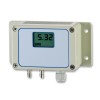 20 kPa negative differential range air pressure gauge and sensor with tubing fitting - Digital display negative differential pressure gauge and sensor for use in vacuum air measurement applications, capable of measuring 0 to 20 kPa DP with 1% accuracy and connected using a 6.6 x 11 mm tube fitting.
20 kPa negative differential range air pressure gauge and sensor with tubing fitting - Digital display negative differential pressure gauge and sensor for use in vacuum air measurement applications, capable of measuring 0 to 20 kPa DP with 1% accuracy and connected using a 6.6 x 11 mm tube fitting.

